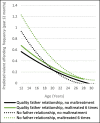Disrupting the link between maltreatment and delinquency: how school, family, and community factors can be protective
- PMID: 31101102
- PMCID: PMC6525373
- DOI: 10.1186/s12889-019-6906-y
Disrupting the link between maltreatment and delinquency: how school, family, and community factors can be protective
Abstract
Background: Past experiences of childhood maltreatment are common for youth involved in the juvenile justice system. This paper explores potential protective factors at the peer, family, school, and neighborhood levels that disrupt the relationship between maltreatment and later non-violent and violent offending behavior and how these protective effects vary by a number of different sociodemographics.
Methods: We used data from the National Longitudinal Study of Adolescent to Adult Health (Add Health), a nationally representative longitudinal study of adolescents who were in grades 7-12 in the 1994-95 school year. Pulling data from Add Health respondents from ages 13 to 30, we used linear mixed effects modeling to create growth curves of predicted violent and non-violent offending frequency from adolescence into young adulthood, with maltreatment frequency as a predictor. Next, we tested whether potential protective factors including time with friends, a high-quality relationship with a parent figure, school connection, or neighborhood collective efficacy moderated the intercept or slope of the growth curves. Finally, we tested if sex, race/ethnicity, or sexual orientation moderated these protective effects.
Results: For violent offending, school connection, high-quality relationships with mother or father figures, and neighborhood collective efficacy were all generally protective, meaning they were associated with lower levels and shallower slopes of predicted violent offending, but they were not more or less protective for those who experienced maltreatment. For non-violent offending, the same was true of school connection, high-quality relationships with a mother figure, and neighborhood collective efficacy, which were all generally protective. We found no evidence of a protective effect for time spent with friends, though this is likely due to measurement constraints, as simply measuring time spent with friends may have heterogeneous effects on delinquent behaviors. We found no evidence that any of these protective effects varied by sociodemographics.
Conclusions: This paper identifies factors that teachers, juvenile corrections officers, policymakers and others can intervene on to prevent engagement (or re-engagement) in delinquency and offending among youth and young adults who experienced maltreatment. As they are also protective for youth who have not experienced maltreatment they also inform general delinquency prevention efforts.
Keywords: Abuse; Delinquency; Maltreatment; Neighborhood collective efficacy; Non-violent; Parental relationship quality; Protective factors; School connection; Violent.
Conflict of interest statement
The authors declare that they have no competing interests.
Figures




Similar articles
-
Describing associations between child maltreatment frequency and the frequency and timing of subsequent delinquent or criminal behaviors across development: variation by sex, sexual orientation, and race.BMC Public Health. 2019 Nov 12;19(1):1306. doi: 10.1186/s12889-019-7655-7. BMC Public Health. 2019. PMID: 31711444 Free PMC article.
-
Impact of a universal school-based violence prevention program on violent delinquency: distinctive benefits for youth with maltreatment histories.Child Abuse Negl. 2011 Jun;35(6):393-400. doi: 10.1016/j.chiabu.2011.03.002. Epub 2011 Jun 8. Child Abuse Negl. 2011. PMID: 21652072 Clinical Trial.
-
Does a Close Relationship With an Adult Reduce the Risk of Juvenile Offending for Youth With a History of Maltreatment?Child Maltreat. 2020 Aug;25(3):308-317. doi: 10.1177/1077559519883010. Epub 2019 Nov 10. Child Maltreat. 2020. PMID: 31709813
-
Maltreatment of adolescents: the relationship to a predisposition toward violent behavior and delinquency.Adolescence. 1983 Fall;18(71):499-506. Adolescence. 1983. PMID: 6359828 Review.
-
Review of research on child maltreatment and violence in youth.Trauma Violence Abuse. 2008 Jan;9(1):56-67. doi: 10.1177/1524838007311105. Trauma Violence Abuse. 2008. PMID: 18182631 Review.
Cited by
-
Preschool Aggression and Victimization: A Short-Term Longitudinal Analysis of the Immediate Social Environment.Psychol Res Behav Manag. 2024 Feb 28;17:827-851. doi: 10.2147/PRBM.S453572. eCollection 2024. Psychol Res Behav Manag. 2024. PMID: 38434957 Free PMC article.
-
Associations of parent-adolescent closeness with P3 amplitude, frontal theta, and binge drinking among offspring with high risk for alcohol use disorder.Alcohol Clin Exp Res (Hoboken). 2023 Jan;47(1):155-167. doi: 10.1111/acer.14973. Epub 2023 Jan 21. Alcohol Clin Exp Res (Hoboken). 2023. PMID: 36680783 Free PMC article.
-
Positive parent-child interactions moderate certain maltreatment effects on psychosocial well-being in 6-year-old children.Pediatr Res. 2024 Feb;95(3):802-808. doi: 10.1038/s41390-023-02842-5. Epub 2023 Oct 13. Pediatr Res. 2024. PMID: 37833534
-
Adverse childhood experiences and psychological distress among higher education students in Southeast Nigeria: an institutional-based cross-sectional study.Arch Public Health. 2021 Apr 29;79(1):62. doi: 10.1186/s13690-021-00587-3. Arch Public Health. 2021. PMID: 33926542 Free PMC article.
-
Childhood maltreatment and alcohol and tobacco use trajectories in rural Chinese adolescents.Child Adolesc Psychiatry Ment Health. 2024 May 3;18(1):51. doi: 10.1186/s13034-024-00744-w. Child Adolesc Psychiatry Ment Health. 2024. PMID: 38702797 Free PMC article.
References
-
- Centers for Disease Control and Prevention. Child abuse and neglect: Definitions. 2016. https://www.cdc.gov/violenceprevention/childabuseandneglect/index.html. Accessed 14 Feb 2018.
-
- U.S. Department of Health and Human Services, Administration for Children and Families, Children’s bureau. Child maltreatment 2016; 2018. https://www.acf.hhs.gov/sites/default/files/cb/cm2016.pdf.
MeSH terms
Grants and funding
LinkOut - more resources
Full Text Sources
Medical
Research Materials
Miscellaneous

